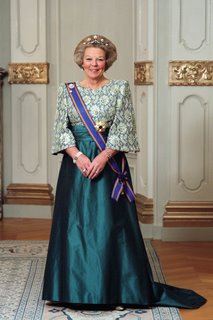Currently there are three European queens regnant: Queen Elizabeth II of Great Britain, Queen Margarethe II of Denmark, and Queen Beatrix of the Netherlands. Prior to their accession, these women were regarded as Heiress Presumptive, (the presumption being that a male might be born to replace them). The history of queens regnant in each country is very different. Denmark has had one Queen Regnant prior to Margarethe II; she was Queen Margarethe I (1387-1412) although she acted as regent until her son came of age. England has had six queens regnant. In the Netherlands, Queen's ruled the 20th century and when Beatrix's son, Willem-Alexander, succeeds he will be the first male monarch in over a century.
Despite having an illustrious history of female monarchs, the United Kingdom, like Denmark, still follows male primogeniture. However, the Netherlands, Sweden, Norway and Belgium have changed their succession laws to allow the firstborn to succeed regardless of gender.
Queen Elizabeth II of the United Kingdom
 Of the three queens regnant, Elizabeth II has reigned the longest. She is the oldest queen, but at the age of 25 she was the youngest to come to the throne. At the time of her birth, she was third in line and her chances of becoming queen were remote. It wasn't until her uncle King Edward VIII abdicated in 1936, that she became heiress presumptive. She had one younger sister, the late Princess Margaret. In 1947 she married Prince Philip, Duke of Edinburgh and they have four children: Prince Charles, the Prince of Wales (born 1948), the Princess Royal (born 1950), Prince Andrew, Duke of York (born 1960), and Prince Edward, the Earl of Wessex, (born 1964).
Of the three queens regnant, Elizabeth II has reigned the longest. She is the oldest queen, but at the age of 25 she was the youngest to come to the throne. At the time of her birth, she was third in line and her chances of becoming queen were remote. It wasn't until her uncle King Edward VIII abdicated in 1936, that she became heiress presumptive. She had one younger sister, the late Princess Margaret. In 1947 she married Prince Philip, Duke of Edinburgh and they have four children: Prince Charles, the Prince of Wales (born 1948), the Princess Royal (born 1950), Prince Andrew, Duke of York (born 1960), and Prince Edward, the Earl of Wessex, (born 1964).Queen Margarethe II of Denmark

Although she was the eldest child of the Crown Prince and Princess of Denmark, when Queen Margarethe was born, women did not have rights to inherit the throne at all. Her uncle was next in line until a 1953 referendum made Princess Margarethe heiress presumptive. When her father died in 1972, she became the first Queen regnant under the new Act of succession. Queen Margarethe is considered to be the most intellectual monarch - studying at no fewer than five universities. She is also extremely accomplished as an artist and writer. Queen Margarethe is regarded as Europe's most modern and progressive monarchs; openly granting interviews and making herself easily accessible to her subjects. The Queen has two younger sisters, Princess Benedikte and Queen Anne-Marie of Greece. In 1967 she married French diplomat, Count Henri deLaborde de Monpezat (Prince Henrik upon marriage). They have two sons: Crown Prince Frederik (born 1968), and Prince Joachim (born 1969).
Queen Beatrix of the Netherlands
 Queen Beatrix is the fourth successive female sovereign in the Netherlands. She was the first of four daughters born to Queen Julianna and Prince Bernhard. She has three younger sisters - Princess Irene, Princess Margriet, and Princess Christina.
Queen Beatrix is the fourth successive female sovereign in the Netherlands. She was the first of four daughters born to Queen Julianna and Prince Bernhard. She has three younger sisters - Princess Irene, Princess Margriet, and Princess Christina.Like Queen Margarethe, Queen Beatrix is academically well educated, studying international and European law and international relations. She earned a law degree in 1961.
Unlike Queen Elizabeth II and Queen Margarethe II who succeeded upon the deaths of their fathers, Beatrix succeeded upon the abdication of her mother, Queen Juliana, in 1980. At 42 she was the oldest of the three to ascend the throne. In the Netherlands, abdication has become something of a tradition, although it is unknown whether she will choose to do so in favour of her eldest son.
In 1966, she married a German diplomat, Claus von Amsberg (upon marriage he became Prince Claus). They had three sons: Crown Prince Willem-Alexander (born 1967), Prince Johan Frisco (born 1968), and Prince Constantijn (born 1969). Prince Claus died in 2002.
The future
With the changes in succession laws, allowing for the first born to succeed regardless of gender, in the future we will see queens regnant on the thrones of Belgium (Princess Elisabeth), Norway (Princess Ingrid Alexandra), the Netherlands (Princess Catharina-Amalia), and Sweden (Crown Princess Victoria). If the succession rules are changed we might even see Princess Aiko as Empress of the Chrysanthemum throne, and the newborn Infanta Leonor as the first Queen of Spain in over 150 years.
God save the Queens
© Marilyn Braun
For more information check out the Official British, Danish and Dutch sites.


No comments:
Post a Comment